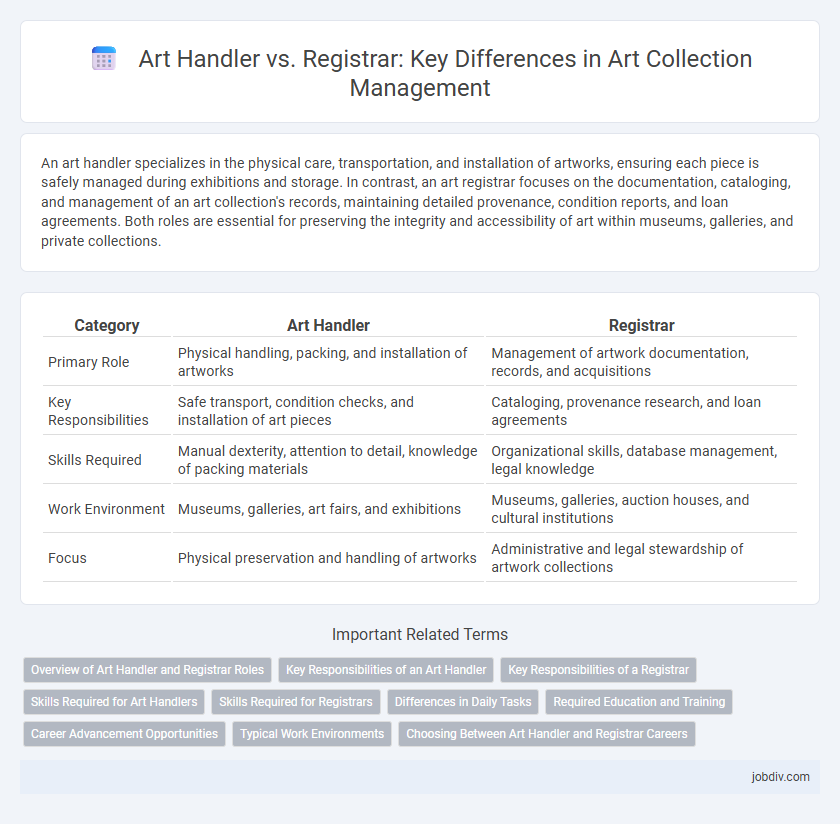An art handler specializes in the physical care, transportation, and installation of artworks, ensuring each piece is safely managed during exhibitions and storage. In contrast, an art registrar focuses on the documentation, cataloging, and management of an art collection's records, maintaining detailed provenance, condition reports, and loan agreements. Both roles are essential for preserving the integrity and accessibility of art within museums, galleries, and private collections.
Table of Comparison
| Category | Art Handler | Registrar |
|---|---|---|
| Primary Role | Physical handling, packing, and installation of artworks | Management of artwork documentation, records, and acquisitions |
| Key Responsibilities | Safe transport, condition checks, and installation of art pieces | Cataloging, provenance research, and loan agreements |
| Skills Required | Manual dexterity, attention to detail, knowledge of packing materials | Organizational skills, database management, legal knowledge |
| Work Environment | Museums, galleries, art fairs, and exhibitions | Museums, galleries, auction houses, and cultural institutions |
| Focus | Physical preservation and handling of artworks | Administrative and legal stewardship of artwork collections |
Overview of Art Handler and Registrar Roles
Art handlers specialize in the physical care, transportation, and installation of artworks, ensuring their safety and preservation during handling. Registrars manage detailed documentation, provenance, condition reports, and loan agreements, maintaining the integrity of collection records. Both roles are crucial in museum and gallery operations, with art handlers focusing on logistics and registrars on administrative oversight.
Key Responsibilities of an Art Handler
Art handlers specialize in the physical management of artworks, ensuring safe packing, transportation, installation, and storage to prevent damage. They possess expertise in handling diverse materials, using custom supports and climate-controlled conditions to maintain conservation standards. Their role is critical in preparing artworks for exhibitions, collaborating closely with registrars who manage documentation, provenance, and legal aspects.
Key Responsibilities of a Registrar
A Registrar in the art world manages the documentation, provenance, and condition reports of artworks to ensure accurate records and facilitate smooth transactions and exhibitions. They oversee inventory control, coordinate logistics for loans and acquisitions, and maintain compliance with legal and ethical standards. Their key responsibilities include cataloging collections, tracking movement of pieces, and collaborating with curators and conservators to safeguard art assets.
Skills Required for Art Handlers
Art Handlers require meticulous attention to detail, physical strength, and knowledge of proper packing and transportation techniques to ensure the safety of artworks. Proficiency in handling diverse materials, preventive conservation skills, and familiarity with climate control are crucial for maintaining the integrity of fragile pieces. Strong communication skills support coordination with curators and registrars, enabling smooth exhibition setups and storage management.
Skills Required for Registrars
Registrars in art institutions require advanced organizational skills, expertise in collection management software, and a deep understanding of provenance documentation to ensure accurate record-keeping and compliance with legal standards. They must possess strong communication skills for coordinating between artists, curators, and lenders while managing complex exhibition logistics and condition reporting. Proficiency in budgeting, risk management, and conservation principles further distinguishes registrars from art handlers, whose skills focus primarily on physical handling and installation.
Differences in Daily Tasks
Art handlers focus primarily on the physical aspects of artwork management, including packing, unpacking, installation, and transportation, ensuring pieces are handled safely and securely. Registrars manage documentation, provenance, condition reports, insurance records, and loan agreements, overseeing the administrative and legal aspects of collection care. While art handlers emphasize hands-on interaction with artworks, registrars ensure accurate record-keeping and compliance with institutional policies and lending standards.
Required Education and Training
Art Handlers typically require a high school diploma or equivalent, with specialized training in art handling techniques, packaging, and condition reporting often obtained through on-the-job experience or vocational courses. Registrars usually hold a bachelor's degree in art history, museum studies, or a related field, supplemented by internships or formal training in collection management, cataloging, and provenance research. Advanced certifications, such as AAM's Certified Registrar program, can enhance qualifications for registrars, emphasizing expertise in legal and ethical aspects of artwork care and documentation.
Career Advancement Opportunities
Art handlers and registrars each offer distinct career advancement pathways within the art world; art handlers can progress to lead technician roles or specialize in conservation, gaining expertise in object care and installation techniques. Registrars typically move into senior management positions, focusing on collection management, provenance research, and museum operations, leveraging their knowledge of art documentation and legal compliance. Both careers benefit from continuous professional development and certifications that enhance skills and open opportunities in larger institutions or specialized galleries.
Typical Work Environments
Art handlers typically work in galleries, museums, auction houses, and art transportation companies, managing the safe packing, moving, and installation of artworks. Registrars often operate within museums, galleries, and cultural institutions, overseeing the documentation, cataloging, and legal compliance of art collections. Both roles demand collaboration in climate-controlled storage and exhibition spaces to ensure the preservation and security of valuable art pieces.
Choosing Between Art Handler and Registrar Careers
Art handlers specialize in the physical care, packing, and transportation of artworks, ensuring safe installation and exhibition setup. Registrars manage documentation, provenance, and collection records, overseeing loan agreements and compliance with legal standards. Choosing between these careers depends on whether you prefer hands-on work with art objects or administrative responsibilities related to collection management.
Art Handler vs Registrar Infographic

 jobdiv.com
jobdiv.com